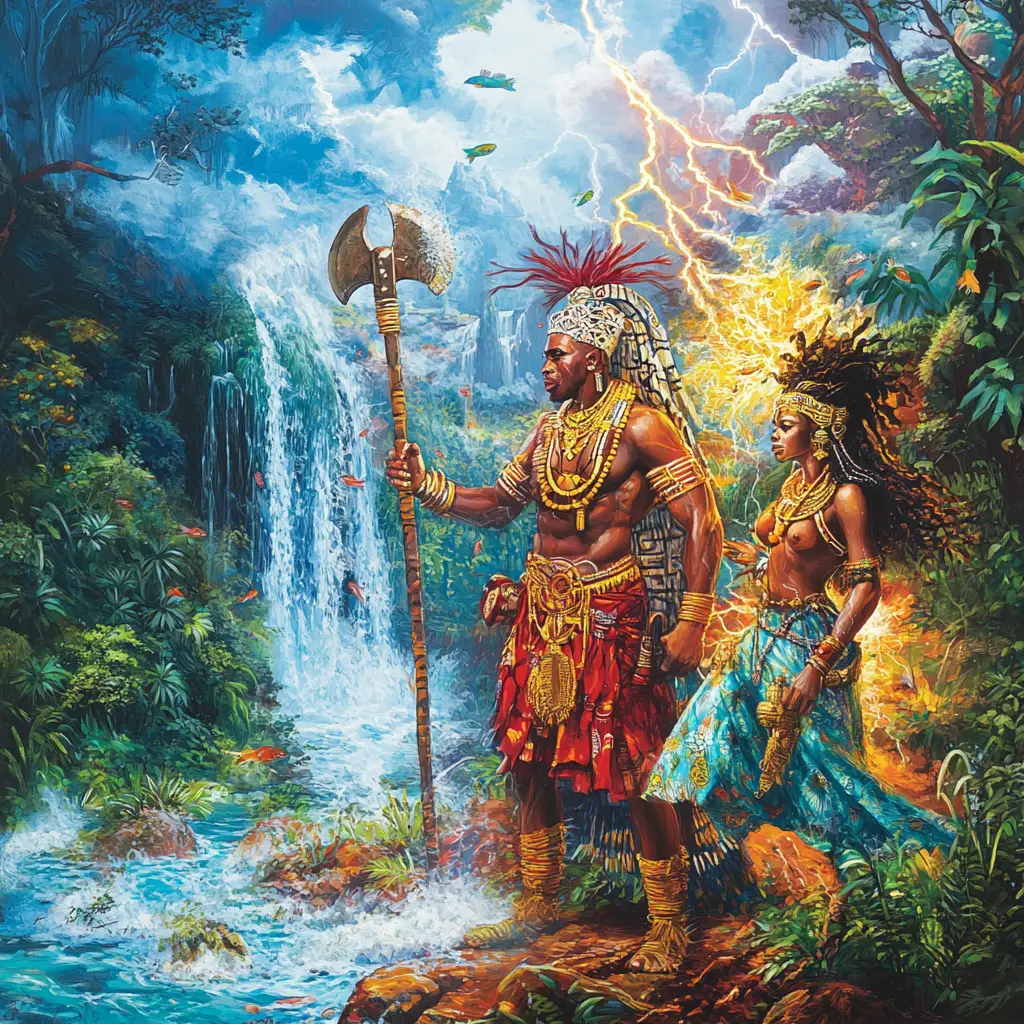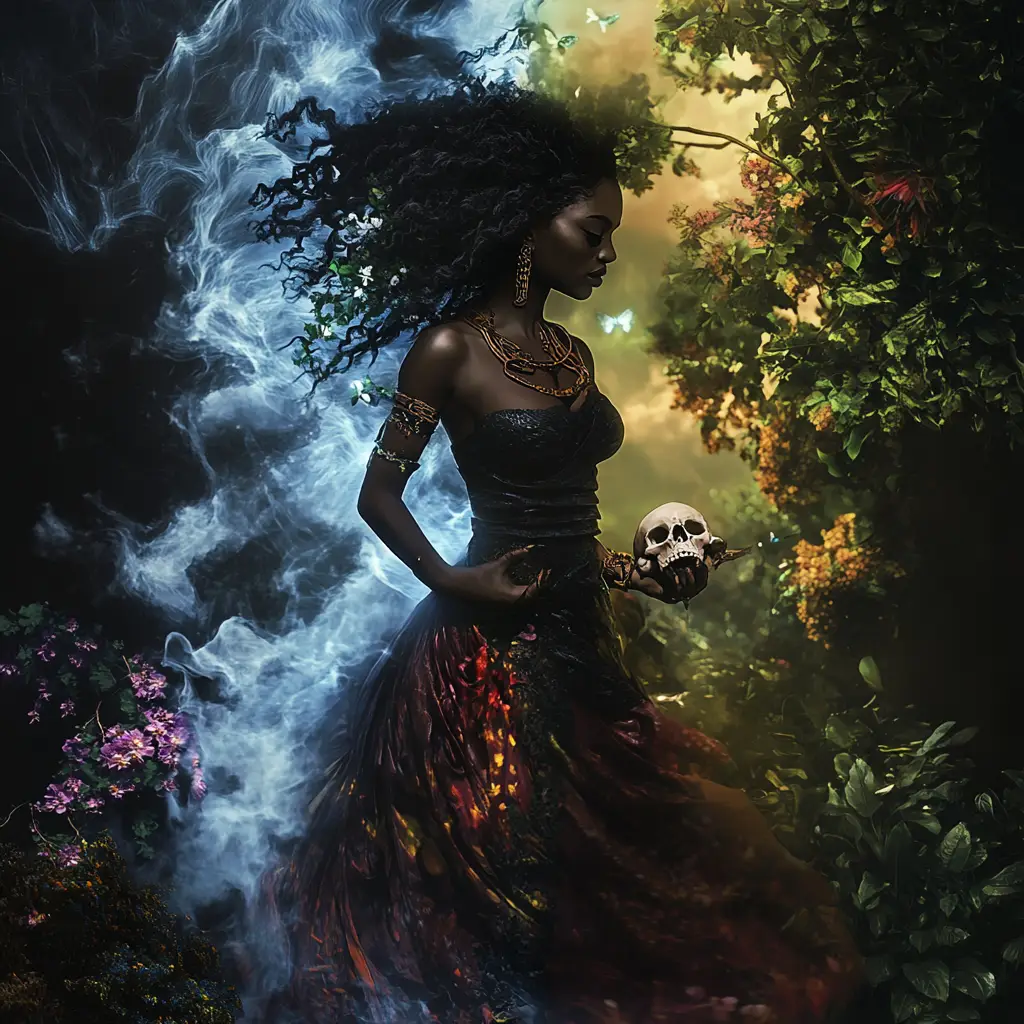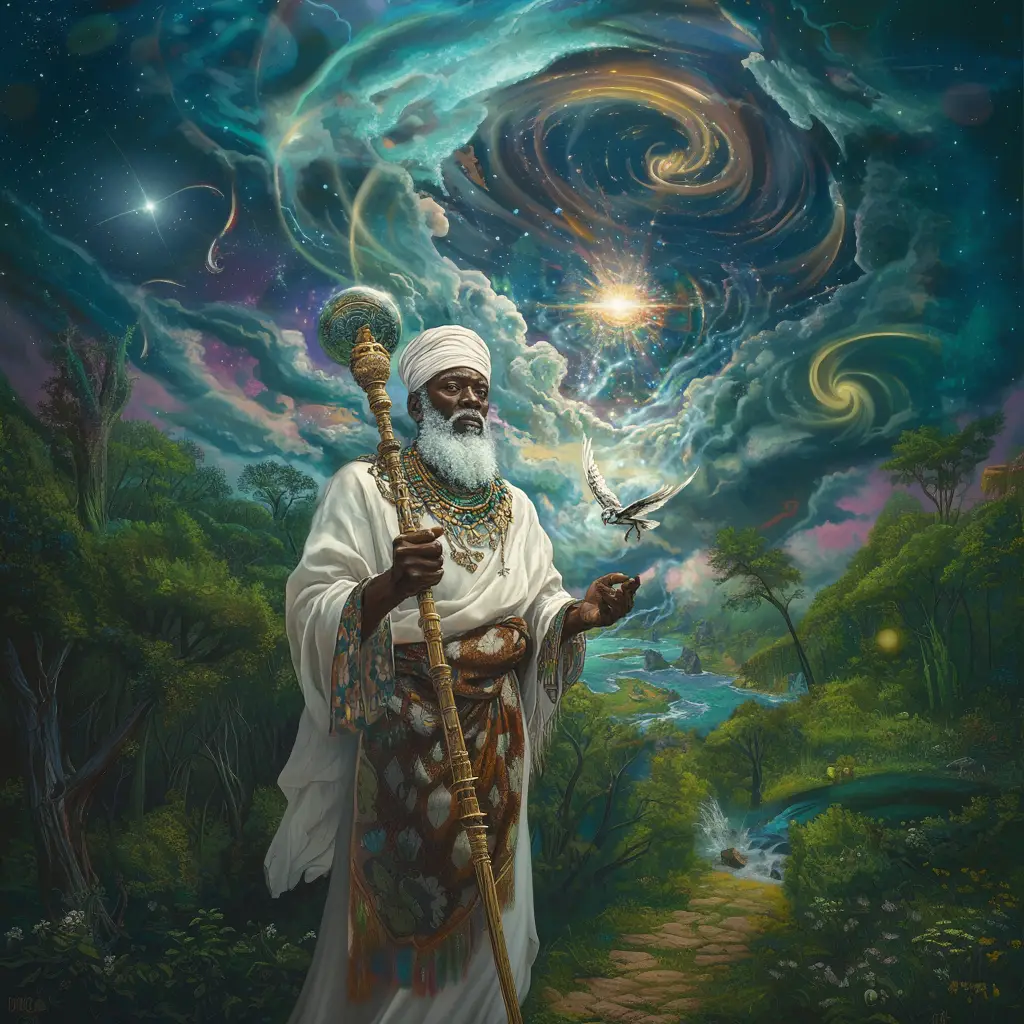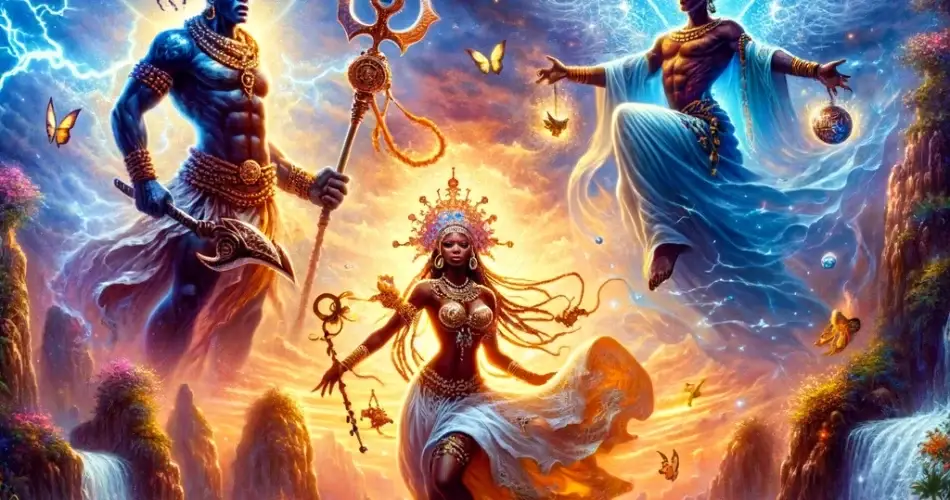Orishas in Yoruba culture are supernatural beings or spirits that mediate between the human and spiritual worlds. According to Yoruba mythology, these supernatural entities are messengers of the supreme Yoruba god Olodumare.
The worship of the Orishas is believed to have started in the ancient Yoruba land, which spans parts of present-day Nigeria, Togo, Benin, and Ghana. These supernatural entities played a significant role in shaping the religion, culture, civilization and mythology of the Yoruba people.
Who are the Orishas?
Ara Orun Vs Irunmole in Yoruba Mythology
According to Yoruba oral history, the Orishas originated from Olodumare, the supreme god. After their creation, they lived with him in heaven for millennia before the Earth was created.
These primordial gods who lived with Olodumare before the creation of the world are referred to as Ara Orun, which translates to “persons of heaven” in the Yoruba language.
However, after Earth was created, things started to change. The First Men were utterly clueless and confused about the ways of the world. Their lack of knowledge made them very weak, and they died very easily.
To help humankind survive, Olodumare sent some Orishas to the Earth with instructions to guide and teach the first men. Their mission was to help shape the world, establish order, and guide humanity in spiritual and moral practices.

These deities took mortal bodies and came down to Earth to live among men. These supernatural beings were called “Irunmole”, which roughly translates to “Divine beings on earth”.
Since they were supernatural beings, they had special talents and could control the previously untamable and wild elements of the Natural world. They taught the first men medicine, rituals, spirituality, and the arts. They also helped them understand how to harness the powers of elements like fire, water, wind, and the Earth. The knowledge of these deities helped men live better lives on Earth.
The Orishas Return to Heaven
While on Earth, the Orishas helped men with their many talents and powers. In return, they held important positions, including kings, priests, generals, and queens.
However, once their earthly tasks were completed, these supernatural beings returned to Olodumare in Orun, the heavenly realm. This was often through spiritual ascension or transformation into natural elements they govern.
For instance, Obatala, the Orisha of wisdom and purity, is said to have returned to the skies after laying the foundation for human civilization. Oshun, the goddess of rivers and love, is believed to have merged with the river Oshun. Shango, the Orisha of thunder and lightning, is believed to have entered the Earth in the ancient Yoruba town of Oyo.
Hierarchy and Classification of Orishas
Despite these ancient stories, modern Yoruba scholars have classified the Orisha into different categories based on their origin and the natural elements they are associated with.
These categories are not rigid, and they overlap in some cases.
Primordial divinities
As stated earlier, the Primordial Divinities are the Orisha that existed in heaven with Olodumare before the creation of the world and everything within it. They were created by Olodumare to serve as his messengers.
Some of these primordial divinities include Obatala, the creator of the world; Orunmila, the deity of wisdom and the Oracle; Esu, the god of crossroads; and Olokun, the goddess of the Ocean.
Ancient Heroes and Legends
Another category of Orishas in Yoruba Mythology is the deified ancestors. These Orishas are the people who lived on Earth after it was created. They had such a profound impact on Earth that their memories are still celebrated and preserved long after their death.
They were kings, heroes and heroines, warriors, and founders of major cities. Their contributions to cultural and social life had a big influence on the lives of the Yoruba people.
These ancestors had supernatural powers, and after their death, they are believed to have transformed into Orishas, who were later worshipped by the people. Several primordial divinities have oral traditions stating that they were once the chiefs or kings of still-existing Yoruba towns.
Examples of these Orishas include Sango, Oya, Oshun, and Yemoja.
Personified Elements of Nature
The Yoruba people believed that spirits dwell within Natural phenomena such as rivers, lakes, fire, mountains, and some trees. Although the significance of these spirits varied, they all held important roles in Yoruba mythology and were widely worshipped as Orishas.
To the Yoruba people, these Orishas provided a means to communicate and control these wild and scary elements.
Popular Orishas in Yoruba Mythology
Eshu: The Trickster
Eshu is also known as Elegba in the Orisha Pantheon. Like Loki in Norse mythology, Eshu is a notorious trickster in Yoruba mythology; however, he is more benevolent.
Eshu is the messenger god responsible for carrying messages from men to the spirit world and back. This is probably why he is considered a trickster. Eshu is closely related to another mischievous deity known as Elegua.
Orisha Ogun: Yoruba God of War and Iron
Ogun is among the most revered and powerful Orishas in the Yoruba religion, known as the god of iron, war, and labour. He is also the patron of blacksmiths, warriors, and anyone who works with metal or machinery.
Ogun is often honoured in rituals and ceremonies with offerings of iron objects, rum, and the blood of dogs. His sacred colour is green, representing the forest where he first forged his tools, and his symbol is the machete.
Orisha Sango: Yoruba God of Thunder
In Yoruba mythology, Sango is worshipped as the god of thunder, lightning, fire, and dance. He is believed to have been one of the first kings of the Old Oyo empire.
Sango is often depicted wielding a double-headed axe and wearing a red traditional cloth. His ability to summon thunder and lightning reflects his fiery temperament and his role as a divine judge that strikes down liars, and thieves.
Shango’s domain extends beyond the battlefield. He is also associated with drumming, dancing, and celebration.
Devotees honour Shango with offerings of red wine, chilli peppers, and roosters, as well as through energetic drumming and dance ceremonies that mimic the rumbling of thunder.
Orisha Oshun: Goddess of Fertility, Love and Beauty
Oshun, also known as Osun or Oxum, is one of the most beloved Orishas in the Yoruba religion. She is the goddess of love, fertility, rivers, and fresh waters. Oshun is considered a powerful healer, protector of women and children, and the bringer of prosperity and joy.
Devotees honour Oshun with offerings of honey, cinnamon, oranges, and yellow flowers—gifts that reflect her sweetness and beauty. Her sacred colour is yellow, and her symbols include rivers, fans, and mirrors.
Orisha Obatala: god of peace and creature of the Earth
Obatala, also known as Orishanla, is one of the most revered and ancient Orishas in Yoruba mythology. Regarded as the father of all Orishas and the creator of humankind, Obatala is associated with wisdom, purity, peace, and justice.
Obatala was chosen by the supreme god Olodumare to mould the first humans from clay, making him the divine sculptor of life. His hands shaped humanity, and his breath gave them spirit.
Devotees honour Obatala with offerings of bloodless meat like snails, whole foods, coconut milk, and cool water. His sacred colour is white, symbolizing peace, wisdom, and spiritual purity.
Orisha Oya: goddess of Wind, Violent Storm and the Newly Dead

Orisha Oya, also known as Ọya or Iansã, is a powerful and dynamic Orisha in the Yoruba religion. She is revered as the goddess of winds, storms, transformation, and the newly dead. Oya represents nature’s uncontrollable fury and the necessary renewal that it brings.
Her sacred colours are red, purple, and brown, symbolizing her connection to the elements of fire, wind, and Earth.
Orisha Obaluaye: Master of Healing and Miracles
Obaluaye, also known as Babalú-Ayé, is a revered Orisha in the Yoruba religion, associated with healing, disease, and the Earth. Obaluaye governs over infectious diseases, especially smallpox, and is also a powerful healer who can cure any ailments.
In Yoruba mythology, Obaluaye is often seen as a compassionate and stern figure who walks among the sick and downtrodden. He offers relief and protection to those who honour him.
His sacred colours are red, black, and white, representing the themes of life, death, and rebirth. Obaluaye teaches his followers the value of compassion, humility, and the transformative power of suffering and healing.
Orisha Yemoja: goddess of the Ocean
Yemoja, also spelt Yemọja or Yemayá, is one of the most revered and nurturing Orishas in the Yoruba religion. She is known as the goddess of the Ocean, motherhood, and fertility. She embodies the essence of life, love, and compassion and is often depicted as a maternal figure who nurtures all living things.
Yemoja is associated with the vast, life-giving oceans and rivers. This symbolises her boundless, nurturing energy and her ability to cleanse and heal.
In Yoruba mythology, Yemoja is said to have birthed many of the Orishas, making her a central figure in the pantheon and a symbol of creation and sustenance.
Devotees honour Yemoja with offerings of watermelon, molasses, white flowers, and fish.
Orisha Orunmila: Oracle of Wisdom

Orunmila, also known as Ọ̀rúnmìlà or Orunla, is a revered Orisha in the Yoruba religion. He represents wisdom, knowledge, and divination. As the Orisha of destiny and prophecy, Orunmila is the divine seer with a deep understanding of fate, human nature, and the mysteries of the universe.
He is the custodian of the Ifá divination system, a complex process through which divine messages are communicated to guide individuals on their spiritual journeys and help them align with their true destinies.
According to Yoruba mythology, Orunmila was present at the creation of the world. He has since remained a close confidant of Olodumare, the supreme god. His role as the knower of all secrets makes him a crucial intermediary between the divine and human realms.
Conclusion
In Yoruba traditions, the Orishas exist to help humans reach the goal of self-actualization. However, these entities are not perfect themselves and sometimes get in the way of human beings, often without meaning to, because they each have their personalities and flaws, just as humans do.
Orisha’s devotion profoundly influenced new religions, such as Vodou in Haiti and Santeria in Cuba. Today, people still invoke orishas in personal or communal rituals.
